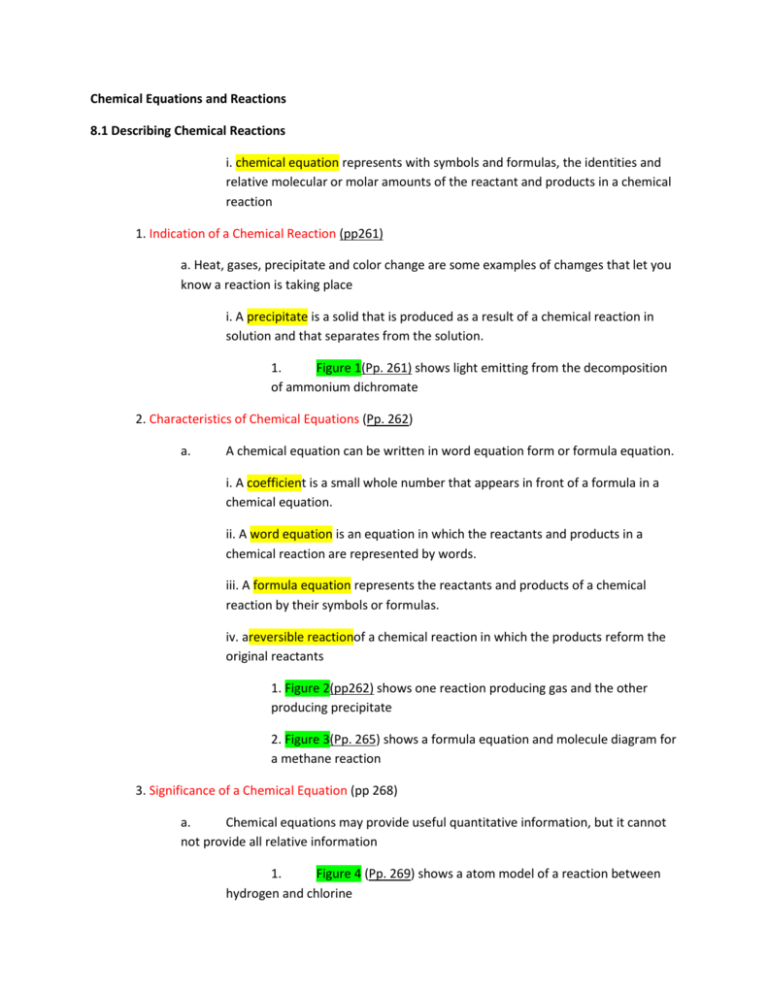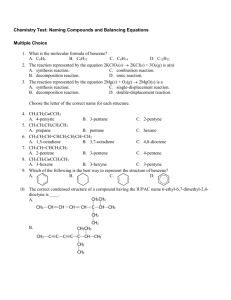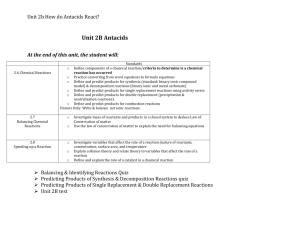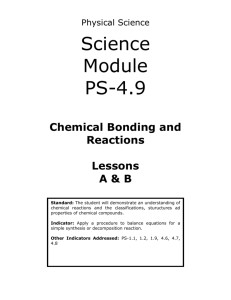File - Introduction
advertisement

Chemical Equations and Reactions 8.1 Describing Chemical Reactions i. chemical equation represents with symbols and formulas, the identities and relative molecular or molar amounts of the reactant and products in a chemical reaction 1. Indication of a Chemical Reaction (pp261) a. Heat, gases, precipitate and color change are some examples of chamges that let you know a reaction is taking place i. A precipitate is a solid that is produced as a result of a chemical reaction in solution and that separates from the solution. 1. Figure 1(Pp. 261) shows light emitting from the decomposition of ammonium dichromate 2. Characteristics of Chemical Equations (Pp. 262) a. A chemical equation can be written in word equation form or formula equation. i. A coefficient is a small whole number that appears in front of a formula in a chemical equation. ii. A word equation is an equation in which the reactants and products in a chemical reaction are represented by words. iii. A formula equation represents the reactants and products of a chemical reaction by their symbols or formulas. iv. areversible reactionof a chemical reaction in which the products reform the original reactants 1. Figure 2(pp262) shows one reaction producing gas and the other producing precipitate 2. Figure 3(Pp. 265) shows a formula equation and molecule diagram for a methane reaction 3. Significance of a Chemical Equation (pp 268) a. Chemical equations may provide useful quantitative information, but it cannot not provide all relative information 1. Figure 4 (Pp. 269) shows a atom model of a reaction between hydrogen and chlorine 4. Balancing Chemical Equations (pp 270) a. It is important to balance equations according the law of conservation 1. Figure 5 (Pp. 270) shows electrolysis of water 5. Describe the differences between the word equations, formula equations, and chemical equations. a. A word equation states the atoms in the reaction using words. A formula equation uses symbols and formulas to represent reactants and products. A chemical reaction also uses symbols and formulas along with molecular or molar amounts to represent reactants and products. 6. Write the word and formula equations for the reaction in which aqueous solutions of sulfuric acid and sodium hydroxide react to form aqueous sodium sulfate and water. a. H2S04 (aq) + 2NaOH (aq) -> Na2S04 (aq) + 2H2O (l) 7. Translate the following chemical equations into sentences: (a) 2K (s) + 2H20 (l) -> 2KOH (aq) + H2 (g); (b) 2Fe (s) + 3Cl2 (g) -> 2FeCl3 (s). a. Solid potassium and water solution react to form aqueous potassium hydroxide and hydrogen gas b. Solid iron and chlorine gas react to for the solid iron chloride. 8. Write the word, formula, and chemical equations for the reaction between hydrogen sulfide gas and oxygen gas that produce sulfur dioxide gas and water vapor. a. Word: Hydrogen sulfide and oxygen react to form sulfur dioxide and water. Formula: 2H2S + 3O2 -> 2SOs + 2 H2O. Chemical equation: 2H2S (g) + 3O2 (g) -> 2SOs (g) + 2 H2O (g). 8.2 Types of Chemical Reactions 1. Synthesis Reactions (pp 276) a. A + X AX i. A synthesis reaction is a composition reaction in which two or more substances combine to form a new compound. 1. Figure 7 (Pp. 277) Shows magnesium undergoing synthesis reaction and producing magnesium oxide 2. Figure 8(pp277) is two types of iron oxides, iron(II) and iron (III) 3. Figure 10(pp278) is calcium hydroxide, a neutralizer for stomach acid 2. Decomposition Reaction (pp 279) a. AX A + X. Opposite of a synthesis reaction i. A decomposition reaction is a single compound that undergoes a reaction that produces two or more simpler substances. ii. Electrolysis is the decomposition of a substance by an electric current. 1. Figure 10 (Pp. 280) is the decomposition of mercury(II) 3. Single-Displacement Reactions (pp 281) a. A+ BX AX +B i. A single-displacement reaction is a replacement reaction in which one electron replaces a similar element in a compound. 1. Figure 11 (Pp. 281) a single displacement reaction of magnesium oxide in HCl 4. Double-Displacement Reactions (pp 282) a. AX+BY AY + BX. Usually one of the compound formed is a precipitate i. Double-displacement reactions are when the ions of two compounds exchange places in an aqueous solution to form two new compounds. 1. Figure 12 (Pp. 282) is a double displacement reaction between lead and potassium iodide. 5. Combustion Reactions (pp 283) a. Natural burning of gas, propane, and gasoline are also combustion reaction i. A combustion reaction is when a substance combines with oxygen, releasing a large amount of energy in the form of light and heat. 1. Figure 13 (Pp. 283) shows the combustion of a a hydrogen filled balloon 6. List five types of chemical reactions. a. Synthesis reactions, decomposition reactions, single -displacement reactions, double displacement reactions, and combustion reactions. 7. Classify each of the following reactions: a. N2 + 3H22NH3 synthesis b. 2Li + 2H2O2LiOH+ H2 single displacement c. 2NaNO3 2NaNO + O2 decomposition d. 2C6H14+ 19O2 12CO2+ 14H2O single displacement 8. A substance is decomposed by an electrical current. What is the name of this type of reaction? a. electrolysis 9. (a) In what environment do many single-displacement reactions commonly occur? (b) In general, how do single-displacement reactions compare with synthesis and decomposition reaction in terms of the amount of energy involved? a. In aqueous solutions many single-displacement reactions commonly occur. b. In general, single-displacement reactions require smaller amounts of energy than synthesis and decomposition reactions. 8.3 Activity Series of the Elements 1. Introduction (pp 285) a. The ability of an element to react is referred to as the element’s activity i. An activity series is a list of elements organized according to the ease with which the elements undergo certain chemical reactions. 2. (a) What is meant by the activity of an element? (b) How does this description differ from metals and nonmetals? a. The ability of an element to react. b. For metals, greater activity means a greater ease of loss of electrons, to form positive ions. For nonmetals, greater activity means a greater ease of gain of electrons, to form negative ions. 3. How is the activity series useful in predicting chemical behavior? a. An activity series is a list of elements organized to predict which elements can react and replace each other 4. (a) What chemical principle is the basis for the activity series of metals? (b) What is the significance of the distance between two metals in the activity series? a. Electronegativity is the basis for the activity series of metals. b. The significance of the distance between two metals in the activity series is to shows if they can replace each other.










